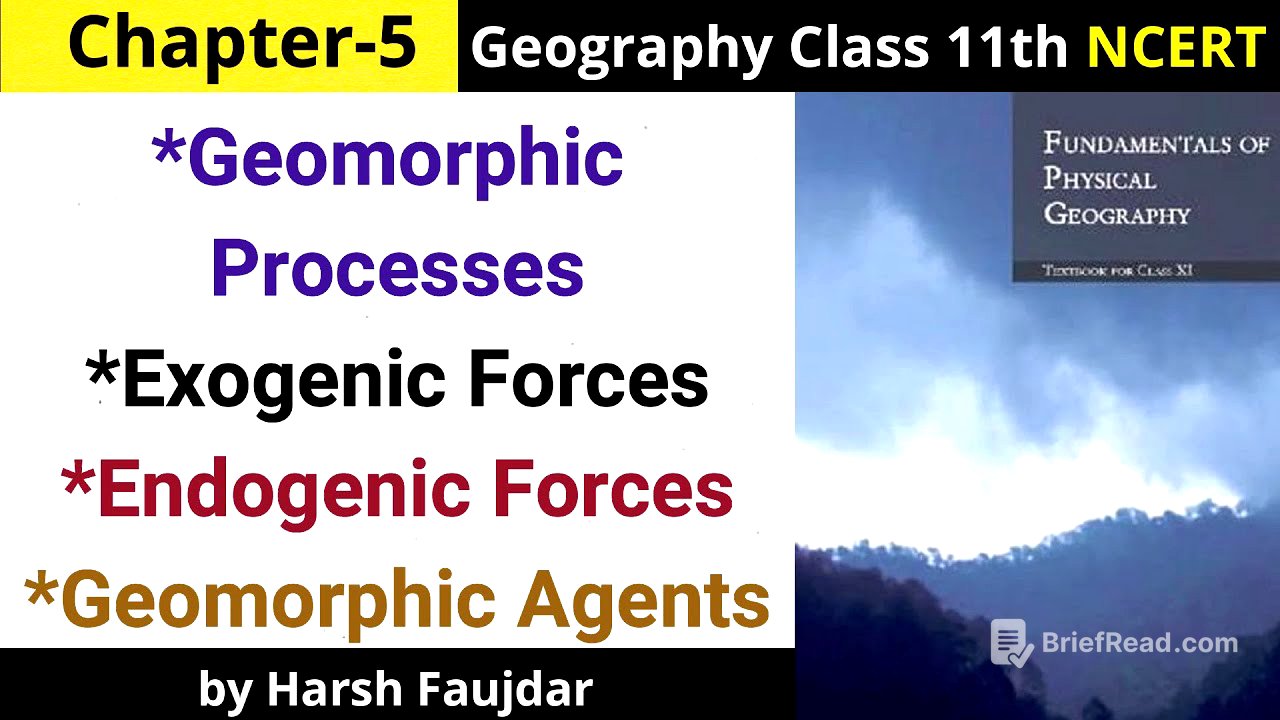TLDR;
This video introduces Chapter 5 of "Fundamentals of Physical Geography," focusing on geomorphic processes. It explains the forces that shape the Earth's surface, differentiating between exogenic (external) and endogenic (internal) forces. The chapter explores how these forces create unevenness on the Earth's surface through degradation and aggradation, and introduces key concepts like geomorphic agents and the roles of gradient and gravity in these processes.
- The Earth's surface is shaped by exogenic and endogenic forces.
- Exogenic forces wear down relief features (degradation), while endogenic forces build them up.
- Geomorphic agents (water, wind, ice) erode, transport, and deposit materials.
- Gradient and gravity are crucial for the mobility of geomorphic agents.
Introduction to Geomorphic Processes [0:00]
The session starts with a resumption of the Fundamentals of Physical Geography series, focusing on Chapter 5, "Geomorphic Processes." The instructor notes that the chapter on "Minerals and Rocks" has been removed from the latest NCERT edition but assures that it will be covered later due to its importance for the UPSC exam. The chapter aims to address why the Earth's surface is uneven, featuring mountains, plains, and plateaus.
Dynamic Earth Crust and Forces [3:09]
The Earth's crust is dynamic, not static, and has experienced both vertical and horizontal movements. The unevenness of the Earth's surface is primarily due to two types of forces: exogenic (external) and endogenic (internal). Exogenic forces operate above the Earth's surface, while endogenic forces operate within the Earth's interior. Differences in the intensity and rate of these internal forces contribute to variations in the Earth's outer surface, such as mountains, plateaus, and plains.
Exogenic vs. Endogenic Forces [9:18]
Exogenic forces impact the Earth's surface by wearing down relief and elevations (degradation) and filling up basins and depressions (aggradation). The wearing down of relief variations due to erosion is called gradation. Endogenic forces, on the other hand, constantly elevate the Earth's surface, acting as land-building forces. The opposing actions of exogenic and endogenic forces result in the variations observed on the Earth's surface. Human activities have damaged the Earth's environment, diminishing its future potential, emphasizing the need for sustainable development.
Geomorphic Processes Defined [20:12]
Geomorphic processes are defined as the physical stresses and chemical reactions on Earth materials caused by endogenic and exogenic forces, leading to changes in the Earth's surface configuration. Examples of endogenic geomorphic processes include diastrophism and volcanism. Processes occurring due to exogenic forces, such as weathering, mass wasting, erosion, and deposition, are called exogenic geomorphic processes.
Geomorphic Agents and Their Role [24:59]
Exogenic elements like water, ice, and wind are termed geomorphic agents. These agents acquire and transport earth materials. Geomorphic agents are mobile mediums that remove, transport, and deposit material. Examples include running water, groundwater, glaciers, wind, waves, and currents. These agents move due to gradient (slope) and gravity, which are essential for their mobility and the resulting erosion, transportation, and deposition. Gravity, a directional force, pulls everything downslope and activates waves, tides, and winds. Without gravity and gradient, these agents would not be mobile, and these processes would not occur.









